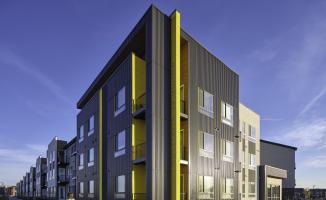Access for All: Critical Design Considerations for Behavioral Health-Focused Senior Housing Communities

A full version of this piece was previously published in "Seniors Housing Business." Read the original piece here.
At a home for seniors with behavioral health conditions, a resident was continually setting off the emergency alarm system. In addition to triggering disruptive, audible alarms multiple times a day, the resident’s actions were costing the facility thousands of dollars for each response.
This is a fairly common occurrence in residential care settings that were not initially designed to house individuals living with behavioral and mental health conditions.
Staff at this home had three options: sedate, restrain, or place the resident in seclusion — all of which would negatively impact the resident. However, this ultimatum was easily avoidable had the space been more intentionally designed for populations with behavioral health needs.
For example, the space could have been planned to avoid public-facing alarm pull stations, or key-operated manual emergency stations could have been specified during the design process. In this case, the building’s design failed its users.
To achieve the ultimate goal of elevating the lives of residents within these communities, the buildings themselves must focus on the resident through thoughtful implementation of design elements that support their unique needs.
Scott Bales & Amy Cheever
With over 20 percent of adults age 60 and over suffering from a mental or neurological disorder, and the World Health Organization (WHO) expecting to see this number increase over the next several years, increasing support for these individuals through design is critical.
At Cuningham, we consider multiple factors when designing for populations with behavioral health needs, seniors included. While traditionally there has been a lack of resources provided to this demographic, programs enacted within the past several years are allowing for more intentional creation of spaces to serve seniors and others with specialized behavioral and mental health needs.
As an example, in California, the Community Care Expansion (CCE) program is working to increase housing and help seniors with histories of mental health or behavioral health issues find housing (in residential care settings) that is specifically designed to meet their needs.
To achieve the ultimate goal of elevating the lives of residents within these communities, the buildings themselves must focus on the resident through thoughtful implementation of design elements that support their unique needs.
Accurate, Intentional Language Frames Design Mission
Within the architecture and design industry, words matter. It is critical that all stakeholders describe the environment of care correctly and are on the same page. This starts with fully understanding who the occupants are — their needs, their wants and how the unique conditions of a particular community serve them.
When it comes to more specific requirements that surround a physical, behavioral or age-related condition, designers should start with accurately describing its users. This has always true in design, but in these cases in particular it is important to think about the individual and all the ways in which they will navigate a space, rather than identifying them by their conditions and the ways they are affected by them.
We must switch from the mindset of designing for a behavioral health condition to designing for a person who is living with a condition and needs to have a thoughtful environment for them to thrive.
Through research and thoughtful conversation with stakeholders, designers can get an accurate, human-centered picture of residents, the realities of their conditions and the challenges they are presented with — whether these are ones a community specializes in serving, or those common among senior populations. We use a combination of evidence-based design, strength-based design and data-driven design as a strategy for creating spaces that will best fit the needs of the occupant.
Design Elements for Behavioral Health
Architects and designers cannot look at behavioral health design as a “one size fits all” approach. It’s important to recognize the multitude of conditions seniors can be living with and that can be compounded by their age.
With this approach in mind, we can create spaces that allow these individuals to thrive.
It is important to design seniors housing, even communities that provide care, to feel more like home and less like an institution. Implementing tunable and flexible lighting into the design is extremely beneficial to residents. It is also important to consider the acoustics of a building, including softening the sounds of alarms and beeping sounds, as those can be a trigger or disrupt the therapeutic environment.
Seniors housing has also seen an uptick in biophilic design — a concept utilized by architects to respond to the innate need of humans to connect to nature through direct and indirect exposure. Studies have consistently revealed that biophilic design can improve cognitive function, physical health and psychological well-being.
Today, we’re seeing this concept increasingly applied to senior living communities. In some locations, strategic design starts with leveraging existing natural surroundings.
Other elements to consider when designing for behavioral health include implementing new types of spaces that are common to behavioral health settings, but not so common to this population, such as comfort rooms or multi-sensory areas. Having access to space away from others where self-soothing or positive distraction can occur is critical to folks living with a disorder. It is important to design a variety of environments to support the residents year-round and throughout the day.
Creating a Supportive Environment for All
When it comes to the staff that are in behavioral health environments, understanding what they need remains a crucial component of the design discussion as well. Due to high levels of burnout, one area that design can support is by providing staff respite.
The care environment, especially in a behavioral healthcare setting, creates a condition known as Chronic Fatigue Syndrome (CFS) — psychological exhaustion due to sustained stimulation without respite. Its ‘cure’ is regular induction of indirect attentional states (mild distracting stimulation without clear focus or intention).
Such states are readily achieved by allowing staff to consistently experience specific natural environmental elements, ranging from gardens to greenery to sunlight and even to water elements.
With this in mind, designers and architects can create space that not only benefits residents, but staff as well — which in turn enhances resident service and care. Physical spaces are deliberately designed to allow staff to decompress, as this represents another important strategy in modern therapy.
While we are designing thoughtful spaces for residents, it is crucial to keep the staff in mind because without them, these seniors with behavioral health conditions would not be able to thrive.
Ensuring that seniors’ varying mental health and physical needs are being met will require action on multiple fronts, including providing them with easy access to the proper resources. Owners and developers of senior living communities have a responsibility to consider these conditions early on so that spaces can be created to better serve this demographic at the design phase.



